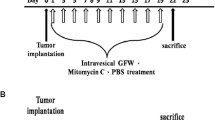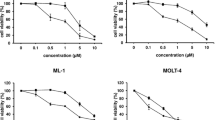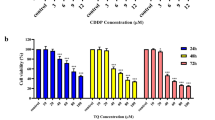Summary
We have compared the in vitro activity of N-trifluoroacetyladriamycin-14-valerate (AD-32) and doxorubicin hydrochloride (ADR) on the clonal growth of human bladder tumor cell lines (HBTCL). In order to determine the relative toxicity of ADR and AD-32 on hematopoietic stem cells, CFU-GM assays were set up using 10 normal human bone marrow samples. The mean lethal dose for 50% of the colonies (LD-50) for ADR was 1.6±1.4 μM and that for AD-32, 3.9±4.9 μM (P<0.55),suggesting that these agents have similar bone marrow toxicity. Both drugs produced enhanced inhibition of clonal growth of HBTCL with increasing C × Ts. The spectrum of activity of the two drugs was similar against a panel of seven HBTCL. The activity of ADR was inhibited at 4 °C while the activity of AD-32 was unaffected by temperature. ADR was more effective against HBTCL in the log growth phase than the plateau phase while the reverse was found using AD-32. Verapamil was found to enhance the activity of both ADR and AD-32 against a HBTCL (T24), found to be resistant to both agents. The lipophilic properties of AD-32, along with its enhanced activity when used over prolonged periods of time and its activity against tumor cells in the plateau phase, suggest that AD-32 could be useful in the management of patients with superficial bladder cancer.
Similar content being viewed by others
Abbreviations
- ADR:
-
doxorubicin hydrochloride
- AD-32:
-
N-trifluoroacetyladriamycin-14-valerate
- HBTCL:
-
human bladder tumor cell lines
- CFU-GM:
-
corony forming units-granulocyte, macrophage
- CFU-T:
-
colony-forming units-tumor
- C × T:
-
concentration × time of drug exposure
- HBSS:
-
Hank's balanced salt solution
- FCS:
-
fetal calf serum
References
Bessman JD, Johnson RK, Goldin A (1975) Permeability of normal and cancerous rat bladder to antineoplastic agents. Urology 6: 187
Bubenik J, Baresoma M, Viklicky V, Jakoubkova J, Sainerova H, Donner J (1973) Established cell line of urinary bladder carcinoma (T24) containing tumor-specific antigen. Br J Cancer 11: 765
Burgess AW, Wilson EM, Metcalf D (1977) Stimulation by human placental conditioned medium of hematopoietic colony formation by human marrow cells. Blood 49: 573
Edsmyr F, Berlin T, Bomen J, Duchek M, Esposti PL, Gustafsson H, Wijkstrom H, Collste LG (1980) Intravesical therapy with adriamycin in patients with superficial bladder tumors. Eur Urol 6: 132
Elliott AY, Bronson DL, Cervenka J, Stein N, Fraley EE (1977) Properties of cell lines established from transitional cell cancers of the human urinary tract. Cancer Res 37: 1279
Fogh J (1978) Cultivation, characterization, and identification of human tumor cells with emphasis on kidney, testis, and bladder tumors. Natl Cancer Inst monogr 49: 5
Garnick MB, Griffin JD, Sack MJ, Blum RH, Israel M, Frei E III (1982) Phase II evaluation of N-trifluoroacetyladriamycin-14-valerate (AD-32). In: Muggia FM, Young CW, Carter SK (eds) Anthracycline antibiotics in cancer therapy. Martinus Nijhoff, The Hague, p 451
Garnick MB, Schade D, Israel M, Richie JF (1984) Prophylactic use of intravesical adriamycin in the management of superficial bladder cancer. J Urol 131: 43
Hill BT, Whelan RDH, Rupniak HT, Dennis CY, Rosholt MA (1981) A comparative assessment of the in vitro effects of drugs on cells by means of colony assays or flow microfluorimetry. Cancer Chemother Pharmacol 7: 21
Hollister D Jr, Coleman M (1980) Hematologic effects of intravesical thiotepa therapy for bladder cancer. JAMA 244: 2065
Hug V, Thames H, Blumenschein GR, Spitzer G, Drewinko B (1984) Normalization of in vitro sensitivity testing of human tumor clonogenic cells. Cancer Res 44: 923
Israel M, Modest EJ, Frei E III (1975) N-Trifluoroacetyladriamycin-14-valerate, an analog with greater experimental antitumor activity and less toxicity than adriamycin. Cancer Res 35: 1365
Israel M, Seshadri R, Kumar N (1982) N-Trifluoroacetyladriamycin-14-O-hemiadipate (AD-143), a promising new experimental antitumor agent. Proc 13th Int Cancer Congr 13: 407
Jakse G, Hofstadter F, Marberger H (1981) Intracavitary doxorubicin hydrochloride therapy for carcinoma in situ of the bladder. J Urol 125: 185
Krishan A, Israel M, Modest EJ, Frei E (1976) Differences in cellular uptake and cytofluorescence of adriamycin and N-Trifluoroacetyladriamycin-14-valerate. Cancer Res 36: 2114
Krishan A, Dutt K, Israel M, Ganapathi R (1981) Comparative effects of adriamycin and N-trifluoroacetyladriamycin-14-valerate on cell kinetics, chromosomal damage, and macromolecular synthesis in vitro. Cancer Res 41: 2745
Levin M, Silber R, Israel M, Goldfeder A, Khetarpal VK, Potmesil M (1981) Protein-associated DNA breaks and DNA-protein crosslinks caused by DNA non-binding derivatives of adriamycin in L1210 cells. Cancer Res 41: 1006
Lohrmann HP, Schroml W, Lang M, Betxler M, Fliedner TM, Heimpel H (1978) Changes of granulopoiesis during and after adjuvant chemotherapy of breast cancer. Br J Haematol 40: 369
Meriwether WD, Bachur NR (1972) Inhibition of DNA and RNA metabolism by daunorobucin and adriamycin in L1210 mouse leukemia. Cancer Res 32: 1137
Merrin C, Cartagena R, Wajsman Z, Baumgartner G, Murphy GP (1975) Chemotherapy of bladder carcinoma with cyclophosphamide and adriamycin. J Urol 114: 884
Niell HB, Soloway MS, Wood CA (1985) Effect of concentration and time of drug exposure on clonal growth of murine bladder cancer. Urology 25: 267
Niijima T (1979) Intravesical therapy with adriamycin and new trends in the diagnostics and therapy of superficial urinary bladder tumors. In: Montedison Laekermedol AD (ed) Diagnostics and treatment of superifical urinary bladder tumors. Stockholm, WHO collaborating centre for research and treatment of urinary bladder Cancer, p 37
O'Toole C, Nayak S, Price Z, Gilbert WH, Waisman J (1976) A cell line (Scaber) derived from squamous cell carcinoma of the human urinary bladder. Int J Cancer 17: 707
O'Toole C, Price LH, Ohnuki Y, Unsguard B (1978) Ultrastructure, karyology and immunology of a cell line originated from a human transitional-cell carcinoma. Br J Cancer 38: 64
Park CH, Amare M, Savin MA, Goodwin JW, Newcomb MM, Hoogstraten B (1980) Prediction of chemotherapy response in human leukemia using an in vitro chemotherapy sensitivity test on the leukemic colony forming cells. Blood 55: 595
Parker LM, Hirst M, Israel M (1978) N-Trifluoroacetyladriamycin-14-valerate: additional mouse antitumor and toxicity studies. Cancer Treat Rep 62: 119
Pavone-Macaluso M, EORTC Genitourinary Tract Cooperative Group A (1976) Single drug chemotherapy of bladder cancer with adriamycin, VM-26, or bleomycin. A phase II multicentric cooperative study. Eur Urol 2: 138
Pearlman LF, Chuang RY, Israel M, Simpkins H (1986) The interaction of three second-generation anthracyclines with polynucleotides, RNA, DNA and nucleosomes. Cancer Res 46: 341
Rigby CC, Franks LN (1970) Human tissude culture cell line from a transitional cell tumor of the urinary bladder: growth, chromosome pattern and ultrastructure. Br J Cancer 24: 746
Taetle R, Howell SB, Giuliani FC, Koziol J, Koessler A (1982) Comparison of the activity of doxorubicin analogues using colony-forming assays and human xenografts. Cancer 50: 1455
Tsuruo T, Lida H, Tsukagoshi S, Sakurai Y (1982) Increased accumulation of vincristine and adriamycin in drug-resistant P388 tumor cells following incubation with calcium antagonists and calmodulin inhibitors. Cancer Res 42: 4730
vecchi A, Cairo M, Mantovani A, Sironi M, Spreafico F (1978) Comparative antineoplastic activity of adriamycin and N-trifluoroacetyladriamycin-14-valerate. Cancer Treat Rep 61: 111
Weinstein SH, Schmidt JD (1976) Doxorubicin in advanced transitional cell carcinoma. Urology 8: 336
Wu P-C, Ozol RF, Hatanaka M, Boone CW (1982) Anticancer drugs: effect on the cloning of Raji lymphoma cells in soft agar. JNCI 68: 115
Yagoda A, Watson RC, Whitmore WF, Grabstald H, Middleman MP, Krakoff IH (1977) Adriamycin in advanced urinary tract cancer. Cancer 39: 279
Author information
Authors and Affiliations
Rights and permissions
About this article
Cite this article
Niell, H.B., Hunter, R.F., Herrod, H.G. et al. Effects of N-trifluoroacetyladriamycin-14-valerate (AD-32) on human bladder tumor cell lines. Cancer Chemother. Pharmacol. 19, 47–52 (1987). https://doi.org/10.1007/BF00296255
Received:
Accepted:
Issue Date:
DOI: https://doi.org/10.1007/BF00296255




